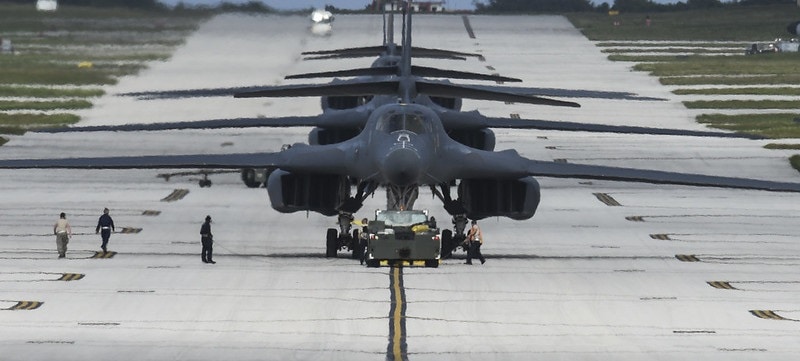On February 25, President Joe Biden ordered an airstrike at a location in eastern Syria against facilities the Pentagon said belonged to or frequented by Iranian-backed militiamen. First reports suggest minimal damage. The strike was in retaliation for militia recent rocket attacks both on the U.S. Embassy in Baghdad and U.S. troops based at the Erbil airport.
Biden deserves praise for signaling the United States would hold Iranian-backed militias accountable for their attacks. He may take some political heat from the progressive left for resorting to military action, and from the Republican opposition who will call out the hypocrisy of both Press Secretary Jen Psaki and Vice President Kamala Harris who questioned the legality of such airstrikes during the Trump administration.
More from 1945:
What a U.S.-Iran War Would Be Like (In a Simulator)
The problem with the strike is two-fold, however. First, he hit the wrong target. Despite Bidens’s efforts to emphasize proportionality, the airstrike was not proportional; rather, it was less. A U.S. Embassy or an airport where U.S. forces reside are not the equivalent of a dusty outpost used as a tea stop for militiamen traversing from Iraq into Syria. Nor are U.S. forces the equivalent of an Iranian-backed militia. A proportional response would more directly target Iranian interests or property. The danger is not Iranian escalation, but rather the normalization of rocket attacks on embassies or airports. Iranian authorities might bluster—they certainly did after Operation Praying Mantis in 1988, or the deaths of Islamic Revolutionary Guard Corps missile chief Hassan Moghadam on November 13, 2011, Qods Force chief Qassem Soleimani on January 3, 2020, or nuclear chief Mohsen Fakhrizadeh in November 27, 2020—but hindsight shows such targeted strike do deter subsequent Iranian actions.

Four B-1B Lancers assigned to the 9th Expeditionary Bomb Squadron, deployed from Dyess Air Force Base, Texas, arrive Feb. 6, 2017, at Andersen AFB, Guam. The 9th EBS is taking over U.S. Pacific Command’s continuous bomber presence operations from the 34th EBS, assigned to Ellsworth AFB, S.D. The B-1B’s speed and superior handling characteristics allow it to seamlessly integrate in mixed force packages. While deployed at Guam the B-1Bs will continue conducting flight operations where international law permit. (U.S. Air Force photo/Tech. Sgt. Richard P. Ebensberger)
In effect, the February 25 strike was the equivalent of President Bill Clinton’s cruise missile attack on the Taliban intelligence ministry in 1998, timed for the night when the building was largely empty. Rather than change Taliban behavior, the group concluded from the American choice of target that they would face no substantive penalty for hosting Al Qaeda and continued to do so until the September 11, 2001 attacks on New York and Washington.
More importantly, Biden’s airstrike suggests that for all his and Secretary of State Tony Blinken’s talk of smart diplomacy, they continue to ignore input from the Iraqi government. In President Barham Salih and Prime Minister Mustafa al-Kadhimi, the White House has a dream team. There is broad consensus among American officials believe that both leaders are sincere in their desire to counter the Iranian-backed militias. While neither Barham nor al-Kadhimi wants Iraq to be a battlefield for Washington and Tehran to play out their proxy battles, both see the existence of the Iranian-backed militias to be affronts to Iraqi sovereignty.
The problem Iraqi leaders face, however, is in the unique problem set that some of these militias present. Iraq’s Counter-Terrorism Service is adept at countering traditional Sunni terrorist groups such as Al Qaeda and the Islamic State that conduct hit-and-run attacks from the countryside, but it is not as able to counter Iranian-backed militiamen who wear suits and infiltrate ministries and other government facilities. After Kadhimi ordered a June 2020 raid on Kata’ib Hezbollah operatives responsible for a rocket attack on the U.S. Embassy, the group responded by marching to within 150 yards of his residence. It was touch-and-go for a while whether Iraqi forces would counter the militiamen. Neither the U.S. Embassy nor U.S. forces in the region did anything to assist the prime minister as he faced mortal danger.
Two problems, therefore, constraining Kadhimi’s ability to take action: First, the possibility that militiamen might outgun Iraqi forces and second, that Iraqi forces might ignore his orders. The best way to counter this would be to create a small special force to which the United States would provide a qualitative military edge and which Kadhimi’s team could vet for loyalty. Only then can Kadhimi realistically take on the militias in the heart of Baghdad.
The militias represent a cancer within Iraqi society and to Iraqi sovereignty. What Iraq needs is a deft surgeon to shrink and remove the tumor. What Biden did on February 25, unfortunately, was the equivalent of slapping a Band-Aid on the patient’s neighbor.
Now a 1945 Contributing Editor, Michael Rubin is a Senior Fellow at the American Enterprise Institute (AEI).

